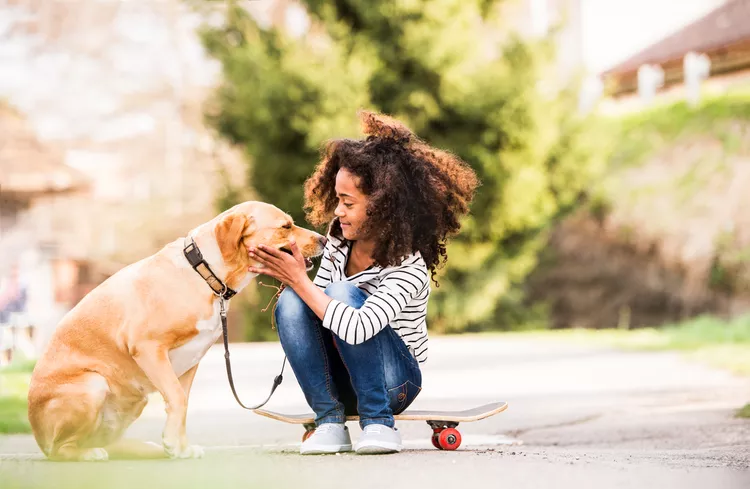How to Train Your Dog to Safely Interact With Kids

Safe interactions between kids and dogs are what every dog-loving parent wants. You may know all about dog bite prevention. You know better than to leave young children and dogs alone together. You have probably even child-proofed your dog. While you can hope that every child should learn how to act around dogs, that isn't always the case. Some do not have a dog at home, may not have a lot of interaction, or just don't follow the rules.
Many children are naturally drawn to dogs. Unfortunately, without the proper tools, kids may not know how to properly behave in order to keep themselves safe. Dog owners can learn to train their dogs to handle kids.
Ask Children to Approach Slowly
As you are out walking your dog on a leash, if you see kids, remind them to never approach a dog without permission. They should always ask a parent first, then the dog's owner. You can teach them not to run toward a dog and approach slowly. No one should not invade the dog's personal space. Let the dog come part way to children, who can hold out the back of their closed hand slightly toward the dog, but not in the dog's face. Let the dog sniff the child. Stoop down to the dog's level if needed (mainly with smaller dogs).
Know When to Say No
If a child asks, it's fine to not allow them to pet your dog. They should learn to never approach a dog that appears anxious, stressed, or fearful. You can usually tell by looking for appeasement gestures or reading body language. Children should avoid approaching a dog when it is eating or chewing on a treat or toy. Sleeping dogs should be avoided since they could startle awake.
Teach Proper Petting
As a dog owner, it can be your responsibility to teach children (either your own or a visitor) the proper way to pet your dog. Start by softly petting the dog's chin or chest. Gentle scratching is also fine, but avoid bringing putting hands over the dog's face and head. If soft petting/scratching of the chin/chest is tolerated, show the child you can gently pet or scratch the neck and back. Go in the direction of the fur.
Make sure the petting stops if the dog backs away, snaps, growls, or demonstrates appeasement gestures or fearful body language.
Enforce Good Behavior Around Dogs
Whether you are a new dog owner or a seasoned one, it's always helpful to remember some good general rules that you can practice to keep your dog and children safe. If you'll have kids meeting your dog for the first time, it can be beneficial to go over some ground rules prior to the meeting. Making sure everyone is clear on the rules will help you safely enforce them. Remove your dog from a situation that is not safe.
- Never pull a dog's ears or tail.
- Don't grab on a dog's feet.
- Avoid hugging dogs. This makes many dogs uncomfortable. If a dog feels threatened enough to bite, your head is dangerously close (the "bite zone").
- Avoid putting your face close to a dog's face. This may invade the dog's personal space.
- Avoid running away from dogs. This may evoke a predatory response. Don't forget, most dogs have some predatory instinct (some more than others).
- Avoid yelling or screaming around dogs. Excessive noise can scare or excite some dogs and may just annoy others.
Problems and Proofing Behavior
A common problem for dog owners is to expect a dog to automatically accept children. With proper training and patience, this can likely be achieved, but for everyone's health and safety, do not rush it.
Make sure the rules are clear with the kids so they don't surprise the dog or catch it off guard. Since many dogs are food motivated, be clear about designated locations for kids to eat and how to eat around their dog. Kids are naturally lower to the ground, so it can be tempting for a dog to have food near its level. A dog may innocently try to grab food but can scare kids when it does so.
If your dog does not respond well to children (and they cannot be avoided), it may be worth working with a canine behavioral specialist. These professionals can help come up with a customized action plan that can help make peace between your dog and the children. While that plan is in place, never leave your dog alone with kids.